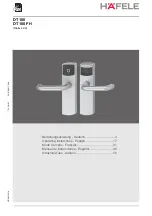
System Memory
CH Control Table
Transfer Buffers Used by
µDMA
µDMA
Controller
‡
‡
‡
DMASRCENDP
DMADSTENDP
DMACHCTRL
DMASRCENDP
DMADSTENDP
DMACHCTRL
DMA Error
DMASTAT
DMACFG
DMACTLBASE
DMAALTBASE
DMAWAITSTAT
DMASWREQ
DMAUSEBURSTSET
DMAUSEBURSTCLR
DMAREQMASKSET
DMAREQMASKCLR
DMAENASET
DMAENACLR
DMAALTSET
DMAALTCLR
DMAPRIOSET
DMAPRIOCLR
DMAERRCLR
General Peripheral N
Registers
Nested Vectored
Interrupt
Controller
(NVIC)
Arm
Cortex-M4F
IRQ
dma_req
dma_done
DMACHMAPn
dma_sreq
General Peripheral N
Registers
dma_req
dma_done
dma_sreq
IRQ
Functional Description
601
SLAU723A – October 2017 – Revised October 2018
Copyright © 2017–2018, Texas Instruments Incorporated
Micro Direct Memory Access (µDMA)
Figure 8-1. µDMA Block Diagram
8.3
Functional Description
The µDMA controller is a flexible and highly configurable DMA controller designed to work efficiently with
the Cortex-M4F processor core of the microcontroller. The µDMA controller supports multiple data sizes
and address increment schemes, multiple levels of priority among DMA channels, and several transfer
modes to allow for sophisticated programmed data transfers. Bus use by the µDMA controller is always
subordinate to the processor core, so it never delays a bus transaction by the processor. Because the
µDMA controller is only using otherwise idle bus cycles, the data transfer bandwidth it provides is
essentially free, with no effect on the rest of the system. The bus architecture has been optimized to
greatly enhance the ability of the processor core and the µDMA controller to efficiently share the on-chip
bus, thus improving performance. The optimizations include RAM striping and peripheral bus
segmentation, which in many cases let both the processor core and the µDMA controller access the bus
and perform simultaneous data transfers.
Each peripheral function that is supported has a dedicated channel on the µDMA controller that can be
configured independently. The µDMA controller implements a unique configuration method using channel
control structures that are maintained in system memory by the processor. While simple transfer modes
are supported, it is also possible to build up sophisticated "task" lists in memory that allow the µDMA
controller to perform arbitrary-sized transfers to and from arbitrary locations as part of a single transfer
request. The µDMA controller also supports the use of ping-pong buffering to accommodate constant
streaming of data to or from a peripheral.
Each channel also has a configurable arbitration size. The arbitration size is the number of items that are
transferred in a burst before the µDMA controller rearbitrates for channel priority. Using the arbitration
size, it is possible to control exactly how many items are transferred to or from a peripheral each time the
peripheral makes a µDMA service request.















































